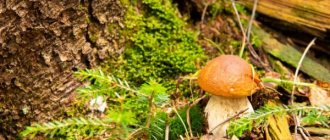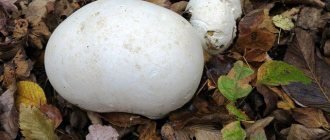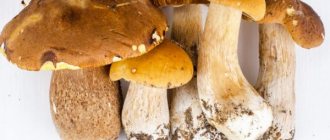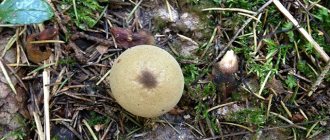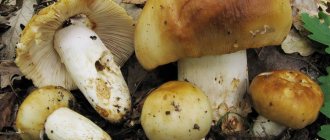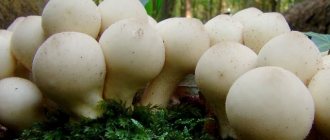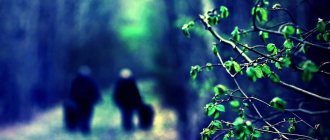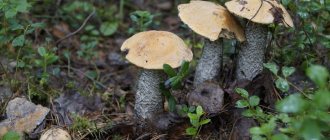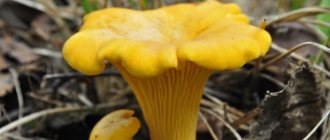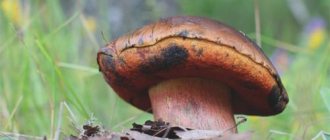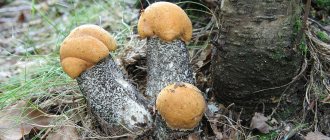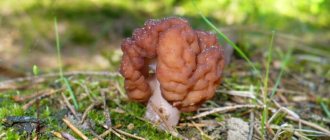An interesting and most striking representative of the flywheel genus is the Polish mushroom. It belongs to the second category of edibility and is considered a gourmet product due to its nutritional properties. The taste is similar to a porcini mushroom, so some mushroom pickers compare it to a handsome white mushroom.
In Russia, this type of moss fly is found in the Siberian and Far Eastern Federal Districts. It grows in European countries, Transcarpathian regions, Poland, where it is popular for its nutritional value and easy digestibility. The active collection period is from June to October.
Description and characteristics of the mushroom
Different classification systems place it in the genera Moss fly (Xerocomus) or Boletus (Boletus), or separate it into an independent species Imleria. It belongs to the Boletov family. Scientific name: Imleria badia. Latin names: Xerocomus badius, Boletus badius. Russian synonyms: chestnut flywheel, pansky mushroom, brown mushroom, bruise, noble flywheel, oleshek.
The cap has a diameter of 4-12 cm (sometimes up to 15). Its shape is convex, semicircular, cushion-shaped and almost flat. The skin does not separate, dry, smooth, slightly sticky in wet weather. When young it is matte, and when mature it is shiny. Its color is chocolate brown, chestnut brown, dark coffee.
The hymenophore (the reverse side of the cap) is tubular, almost free or fused with the stalk. Yellow in color, with a golden or green tint over time.
The pulp has a dense consistency, whitish or yellowish in color. In the cap it turns blue when cut, then becomes lighter, in the stem it turns brown after turning blue. It has a pleasant smell and taste.
The leg is 4–10 cm long, 1–4 cm thick. Cylindrical in shape, sometimes swollen downward or, conversely, narrowed. The structure is fibrous. It is colored yellowish or light brown, with red-brown fibers. Lighter at the top and bottom.
When is it better to avoid flywheels?
The caps of the fly agaric and the panther fly agaric are similar. In a poisonous mushroom it is lamellar, in moss mushrooms it is tubular. Therefore, if you do not have experience in identifying flywheels, it is better not to collect mushrooms unless you understand the peculiarities of the morphology of mushrooms.
Like other species, moss mushrooms are difficult for the human gastrointestinal tract even after cooking. They aggravate the course of stomach and liver diseases, food allergies. Children do not have the enzymes to digest mushroom food, not just fly mushrooms.
Avoid clearings with mushrooms near roads, industrial enterprises and strips near agricultural fields industrially cultivated from the air. Moss mushrooms readily accumulate harmful substances and retain them even after careful preparation.
Time and place of collection in Russia
This charming forest fruit grows mainly in coniferous forests, sometimes found in deciduous groves, and more often on sandy soil.
Settles at the base of trees, on stumps. It tends toward “individualism” and sometimes grows in small groups. Forms mycorrhiza with pine, spruce, European chestnut, oak, and beech.
The habitat of this species includes the northern temperate zone, the European part of Russia, Siberia, the Far East, the North Caucasus, and Belarus. It bears fruit abundantly in Poland and Ukrainian Transcarpathia, where it received the names Pansky and Polish.
The growing time in Russian open spaces is from June to November. Resistant to cold snaps, sometimes found at a time when the rest of the tubular ones have already disappeared.
Related species
The Polish mushroom has long belonged to the boletus or boletus genus. Some classifications still classify this mushroom as one. The genus is quite numerous and in addition to the species, the Polish mushroom includes about 300 species, among which there are both edible, conditionally edible, and inedible (non-toxic), toxic and poisonous. Therefore, we can say that the Polish mushroom has many relatives.
Edible species include:
- maiden boletus (brown-yellow boletus) – Boletus appendiculatus;
- bicolor boletus – Boletus bicolor;
- Burroughs boletus – Boletus barrowsii;
- Fechtner's boletus – Boletus fechtneri;
- semi-white mushroom (yellow boletus) – Boletus impolitus;
- yellow boletus (yellow boletus) – Boletus junquilleus, etc.
The group of inedible, toxic and poisonous species includes:
- beautiful boletus (beautiful boletus) – Boletus calopus – inedible;
- Boletus porosporus (Boletus porosporus) – inedible;
- purple boletus (pink-purple boletus) – Boletus purpureus – inedible;
- legal boletus – Boletus legaliae – toxic;
- beautiful boletus - Boletus pulcherrimus - toxic;
- satanic mushroom – Boletus satanas – toxic, etc.
Growing at home and in the country
Today, avid hobbyists have begun to grow various types of mushrooms at home, gradually turning their hobby into a profitable business. The Polish did not escape this fate either. With proper care, they can reward their owners with a good harvest, more than once a year.
Earth
An area of 2–3 square meters in the shade is suitable for this purpose.
- You need to dig a ditch up to 30 cm deep.
- Pour wood dust, bark, and fallen leaves into a 10 cm thick layer at the bottom. Place earth from under the trees or rotted manure on top.
- Distribute mushroom mycelium evenly over the entire surface of the ditch.
- Cover again with plant debris with a 3 cm layer.
- Finally, add 5 cm of high-quality soil taken from the garden.
Watering and temperature conditions
Immediately after sowing, and also subsequently as necessary, the plantation must be watered, keeping it constantly moist.
This is especially true on hot and dry days. The optimal temperature for cultivation should be from 12 to 26 °C.
Since mushrooms do not have a growing season, they can be grown all year round. But to do this, they should be transplanted from open ground into boxes or boxes.
Fruiting dates
With the correct technique and careful care, the first specimens will appear in 1.5–2 months. New shoots will delight amateur agronomists in one and a half to two weeks.
False doubles
The edible Polish mushroom has doubles. These include benign moss mushrooms: green, brown, variegated. How to determine them?
- U green - a hat of the appropriate color or golden. When cracked it turns yellow. Its tubular hymenophore is whitish-light green, the leg is light in color.
- Brown has a cap with a diameter of 10 cm. It can be colored brown, red or yellow. When cracked, the straw-colored flesh shows through. The saffron-colored leg with a reddish mesh darkens with age.
- Motley It is distinguished by a yellowish cap, which gradually becomes covered with cracks. Through them, the flesh of a pinkish tone is visible.
The listed types cannot be called “bruises”, since when pressure is applied to their surface, spots of this color do not appear. This is the fundamental difference between the chestnut boletus and the boletus, which is similar in appearance.
However, Polish also has dangerous false counterparts, similar to the porcini mushroom and which are also false in relation to it. The table shows comparative characteristics of its poisonous imitators.
| Species names | hat | Pulp | Leg |
| Polish mushroom | Dark coffee, chestnut, chocolate brown. | Color - from white to yellow-greenish. When pressed, it turns blue after 2–5 seconds or becomes greenish-blue. It smells pleasant and has a sweetish taste. | Yellowish or light brown. When cut, it turns bluish, then turns brown, then brightens. |
| Satanic | It has an off-white or olive-gray color. | It turns red when cut , then acquires a dark blue tone. Has an unpleasant smell. | Globular, tuberous . Yellowish-red above, carmine , brownish-yellow below with a clear mesh pattern. |
| Gall | Yellow-brown, gray-ocher, less often dark brown. | The pulp is bitter . Pink at the break . Doesn't turn blue when pressed. | Creamy ocher, with a dark brown reticulate pattern. |
So, we see the main differences between insidious doubles and donkeys. In the satanic one, this is redness when pressed, a fundamentally different (grayish) color of the cap, a different shape and color of the stem, and a bad smell. And gallstone has a pink color of the pulp, its bitterness and the absence of a blue spot upon physical impact.
Edible or not
Edible, belongs to the second class of edibility. It includes species that are high in nutrients. Moss mushrooms are, as a rule, large specimens with a large volume of pulp. Therefore, one copy will be enough for breakfast for two.
Check out
Delicious recipe for creamy porcini mushroom soup
In dishes it is combined with porcini mushrooms. It tastes milder than white. Unlike most whites, it can be eaten raw.
You can also fry it in butter or add it to meat and fish dishes. It is recommended to use younger specimens for first and second courses.
Ripe ones can be suitable for cutting and drying.
The texture of Polish is porous and easily absorbs moisture. Therefore, it does not need to be soaked - just washed .
It is very easy to dry for storage if you first cut it into thin vertical slices. Alternatively, cut into pieces, then freeze for later use.
Evaluation of taste qualities, medicinal properties, benefits and possible harm
Although this species belongs to the second category of edible mushrooms, many put it on a par with boletus in taste.
It is widely used in cooking, it is boiled, fried, baked, stored for the winter - pickled, salted, dried, frozen. It is used to prepare first courses, soups, pie and pancake fillings, appetizers, side dishes, and sauces.
Traditional medicine has long used chestnut moss for medicinal purposes. Its healing effect of Imleria badia is also confirmed by official science. As a result of taking it:
- the body is cleansed of toxins;
- the function of the nervous system is stabilized, susceptibility to stress is reduced;
- the risk of developing atherosclerosis is reduced;
- hair grows better, nails become healthier;
- the healing of abrasions and bruises is accelerated, hematomas, wen and warts are resolved, swelling is relieved;
- it has a diuretic effect.
Systematic consumption of Polish mushroom:
- removes sand from the kidneys;
- normalizes blood pressure;
- thanks to amino acids, improves brain function;
- is the prevention of malignant diseases.
The low calorie content of the deer - 19 kcal - makes it popular in various diets to combat excess weight and vegetarian methods. He contains:
- proteins - 1.7 g;
- fat - 0.7 g;
- carbohydrates - 1.5 g.
However, when collecting, it is worth considering the fact that bruises are capable of accumulating heavy metals and radionuclides, in particular cesium, from the soil and air.
Therefore, you should be careful and look for them in environmentally friendly places, away from production facilities, cities, and roads with active traffic.
Cooking recipes
It’s not for nothing that the Polish mushroom is called a delicacy; it is good in any form, has an exquisite, pleasant taste that can add zest to any dish.
Cooking
Most often, mushrooms are boiled when they need to be added to soup. Some mushrooms are boiled separately, while others, on the contrary, are boiled in broth. In the case of chestnut mushroom, it is better to boil it in broth. In this way, the broth itself will acquire a delicious aroma, as well as a piquant note, and the mushroom, soaked in fat from the broth, will become more juicy.
- To prepare, you need to rinse the Polish mushroom well under water and peel it.
- The legs need to be removed as they are not used in the soup.
- Depending on the diameter of the cap, the mushroom is cut in half or into four parts.
- All the necessary vegetables and other ingredients are added to the already prepared broth.
- The soup is boiled and 10 minutes before it is ready, the Polish mushroom is added to its composition.
It is important that the soup is not very thick, otherwise the mushroom will simply get lost against the background of other ingredients.
Ideal serving of boiled Polish mushroom with sour cream and parsley and in soup.
Pickling
The Polish mushroom can be marinated, then it will be juicy, tasty and interesting.
To marinate it, you must first prepare the mushrooms.
- The skin is cleaned, washed thoroughly, and defects are removed.
- Then cook in boiling water for 10 minutes. The mushrooms need to be removed from the boiling water and allowed to dry.
- It is recommended to cut the mushrooms in half, but if they are large enough, cut them into quarters. The legs are cut off and chopped.
- The mushrooms are packed very tightly into the jar.
- Between them you need to have time to throw peppercorns and bay leaves.
- For pickling, you need to mix 3 tablespoons of 9 percent vinegar. 100 ml water. Salt and sugar to taste.
- Mushrooms are poured with this mixture and then carefully closed with a lid.
- It is recommended to store pickled mushrooms in a cool place.
Pickling
Salted Polish mushroom will also be a real discovery for your guests.
To prepare salted Polish mushrooms, they must be prepared.
- They are thoroughly washed under running water. Clean the cap and remove defects.
- Separate the stem from the cap.
- First, put a pan of water on the fire and bring it to a boil.
- Add bay leaf, peppercorns and salt to the pan.
- Place the mushrooms there and wait for them to boil for exactly 10-15 minutes.
- Remove the mushrooms from the heat and let them dry.
- Then, you need to prepare the composition. Mix 2 tablespoons salt, one tablespoon sugar, 1 liter of water.
- Place the entire mixture on the fire and let it boil.
- After the time is up, add the juice of half a lemon to the mixture.
- Cool the mixture.
- Place a few cloves of peeled garlic at the bottom of the jar. A couple of bay leaves.
- Place the mushrooms very tightly into the jar.
- Fill with the resulting cooled solution.
Drying
Polish mushroom is most often prepared to make a tasty and savory condiment.
In order to dry the Polish mushroom, you must first prepare it.
- Clean the mushrooms from any debris.
- Place them in a pan and fill them with water.
- Wait until all the dirt and debris float to the top.
- Rinse each mushroom thoroughly under running water.
- Dry thoroughly with a towel and give them a couple of hours for the mushrooms to dry at room temperature.
- Then, depending on the size of the mushroom itself, cut them into two or four parts at once.
- As a rule, mushrooms whose cap diameter is more than 6 cm are cut into four parts.
- After the mushroom is cut, all the pieces must be carefully placed on baking paper and placed in the oven at a temperature of 40 degrees. It is important to turn on the upper and lower heating elements.
- Depending on the weight of your mushrooms, as well as the intensity of the heat, it will take from 2 to 5 hours to dry the mushrooms.
- As soon as the mushrooms become dry and easily break in your hands, and have also lost 2/3 of their original volume, you can take out a baking sheet. Don't rush to remove the mushrooms.
- First, let them cool at room temperature.
- Then the mushrooms can be placed in a special container and stored in a dark place or ground into powder.
Canning for the winter in jars
There are many delicious recipes for preserving Polish mushrooms for the winter. However, one of the most enjoyable is the garlic mushroom.
- To prepare this preservation, you will need to carefully prepare the mushrooms and rinse them well.
- Dry and cut into several pieces.
- Boil in boiling water for 10 minutes.
- After this, the mushrooms need to be removed and dried.
- In a separate saucepan you need to mix 1 liter of water.
- Put 4-5 cloves of garlic, one onion, half a carrot in it.
- Add 2 teaspoons of salt, a pinch of sugar, a little citric acid, bay leaf.
- Mix the whole mixture thoroughly and put on fire.
- Bring to a boil and simmer for exactly 5 minutes.
- The resulting liquid must be filtered and allowed to cool.
- Mushrooms are immersed in sterilized jars, and then filled with the resulting liquid.
Fried Polish mushrooms with onions
Mushrooms are best served with potatoes and onions. However, the Polish mushroom behaves ideally as a snack, fried with onions.
To prepare it, you must first prepare the mushrooms, rinse them thoroughly and dry them.
- Slice the Polish mushroom into thin slices, including the stem and cap.
- Also, cut a medium onion into rings.
- For the recipe you will need at least five hundred grams of mushrooms.
- Place the frying pan on the fire.
- Once the oil is hot, add the onion. Fry until golden.
- Then add the mushrooms to the onion and fry until they release juice.
- Fry everything together until the juices have evaporated and the mushrooms have a roasted aroma.
- Season the dish with pepper and salt to taste.
- Be sure to chop the green onions and parsley on top.
Serve as a separate appetizer or as an ingredient for the main course.
Salad
If you have pickled Polish mushroom, you are very lucky. You can prepare an incredibly tasty and healthy salad that will become a real highlight of your table.
- Cut the Polish mushroom into small cubes.
- Then, take a couple of pickled cucumbers and also cut them into small cubes.
- You will need one can of canned peas.
- Cut the ham into small cubes.
- Finally, you will need onions, which also need to be cut into small pieces.
- All ingredients are thoroughly mixed, after which you can add salt and pepper if necessary.
- Squeeze out a small amount of lemon juice.
- It is better to season such a salad with olive or sunflower oil, but sunflower oil mixed with olive oil, pumpkin oil and flaxseed oil are ideal alternatives.
Stewed Chestnut Mosquito
If you are a supporter of healthy and proper food, then you cannot pass up this stewed mushroom recipe. To make the dish more satisfying, you will need additional ingredients.
It's great if you have a slow cooker.
- Cut the chicken fillet into small pieces and fry it well until the chicken turns golden brown.
- Then remove the chicken and fry the onion in the remaining oil.
- After this, turn off the frying mode.
- Cut the potatoes into cubes.
- Cut the carrots into slices.
- Add onion to fried chicken.
- Place Polish mushroom on top.
- Add a couple of bay leaves, pepper, salt the dish and add your favorite spices.
- Fill with water so that it covers the mushrooms completely.
- Set the stew mode and leave for an hour and a half.
Before serving, it is recommended to sprinkle the dish with parsley and dill.
The Polish mushroom is not so easy to find in central Russia. Finding it is the exception rather than the rule.
Therefore, many even experienced mushroom pickers have little idea what kind of mushroom it is, how to use it, and most importantly, how to distinguish it from similar species.
However, if you are lucky enough to pick a basket of Polish mushrooms, you can be congratulated. A delicious dinner awaits you, because this mushroom has a truly spicy, piquant and memorable taste that does not leave you indifferent.
